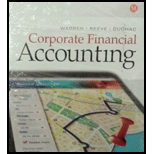
Bond investment: Bond investments are debt securities which pay a fixed interest revenue to the investor.
Debit and credit rules:
- Debit an increase in asset account, increase in expense account, decrease in liability account, and decrease in
stockholders’ equity accounts. - Credit decrease in asset account, increase in revenue account, increase in liability account, and increase in stockholders’ equity accounts.
To journalize: The bond investment transactions of S Products.
Explanation of Solution
(a)
Prepare journal entry for purchase of $120,000, 5% bonds of I Incorporation at 100% with an accrued interest of $1,000.
| Date | Account Titles and Explanations | Post. Ref. | Debit ($) | Credit ($) | |
| Investments–I Incorporation | 120,000 | ||||
| Interest Receivable | 1,000 | ||||
| Cash | 121,000 | ||||
| (To record purchase of M City bonds for cash) | |||||
Table (1)
- Investments–I Incorporation is an asset account. Since bonds investments are purchased, asset value increased, and an increase in asset is debited.
- Interest Receivable is an asset account. Since interest to be received has increased, asset value increased, and an increase in asset is debited.
- Cash is an asset account. Since cash is paid, asset account decreased, and a decrease in asset is credited.
(b)
Prepare journal entry to record the interest revenue received.
| Date | Account Titles and Explanations | Post. Ref. | Debit ($) | Credit ($) | |
| Cash | 3,000 | ||||
| Interest Receivable | 1,000 | ||||
| Interest Revenue | 1,000 | ||||
| (To record receipt of interest revenue) | |||||
Table (2)
- Cash is an asset account. Since cash is received, asset account increased, and an increase in asset is debited.
- Interest Receivable is an asset account. Since interest to be received is received, asset value decreased, and a decrease in asset is credited.
- Interest Revenue is a revenue account. Since revenues increase equity, equity value is increased, and an increase in equity is credited.
Working Notes:
Compute amount of interest received from I Incorporation.
(c)
Prepare journal entry for $60,000 bonds of I International sold at 101%, with an accrued interest of $100.
| Date | Account Titles and Explanations | Post. Ref. | Debit ($) | Credit ($) | |
| Cash | 61,100 | ||||
| Interest Revenue | 500 | ||||
| Gain on Sale of Investments | 600 | ||||
| Investments–I Incorporation | 60,000 | ||||
| (To record sale of I Incorporation bonds) | |||||
Table (3)
- Cash is an asset account. Since cash is received, asset account increased, and an increase in asset is debited.
- Interest Revenue is a revenue account. Since revenues increase equity, equity value is increased, and an increase in equity is credited.
- Gain on Sale of Investments is a revenue account. Since revenues increase equity, equity value is increased, and an increase in equity is credited.
- Investments–I Incorporation is an asset account. Since bond investments are sold, asset value decreased, and a decrease in asset is credited.
Working Notes:
Calculate the cash received from the sale of bonds.
| Particulars | Amount ($) |
| Cash proceeds from sale of $60,000 bonds
|
60,600 |
| Add: Accrued interest revenue | 500 |
| Cash received | $61,100 |
Table (4)
Calculate the realized gain (loss) on sale of $60,000 bonds.
| Particulars | Amount ($) |
| Cash proceeds from sale of $60,000 bonds
|
60,600 |
| Cost of bonds sold | (60,000) |
| Gain (loss) on sale of bonds | $600 |
Table (5)
Want to see more full solutions like this?
Chapter D Solutions
Bundle: Corporate Financial Accounting, Loose-leaf Version, 14th + LMS Integrated for CengageNOWv2, 1 term Printed Access Card
- Financial accounting problemarrow_forwardAssume that the retained earnings of Horizon Industries increased by $76,250 from December 31 of year 1 to December 31 of year 2. During year 2, the company declared and paid cash dividends totaling $18,500. Compute the net income for year 2.arrow_forwardI need financial accounting question answerarrow_forward
- Compute this year's accounts payable turnover ratio for Nashville.arrow_forwardNovaTech Manufacturing has a factory with fixed costs of $720,000 and a production capacity of 250,000 units annually. Its product sells with a 40% contribution margin. The target profit is $500,000. At full production, what does the selling price per unit need to be? Show your complete solution.arrow_forwardRiverfront Manufacturing estimated manufacturing overhead costs for 2024 at $525,000, based on 250,000 estimated direct labor hours. Actual direct labor hours for 2024 totalled 270,000. The manufacturing overhead account contains debit entries totaling $548,000. The manufacturing overhead for 2024 was a) $19,000 overallocated b) $19,000 under allocated c) $23,000 overallocated d) $23,000 underallocatedarrow_forward
- What is the gross margin for the month under absorption costing?arrow_forwardNewton Company prepared the following sales budget: Month Budgeted Sales July $8,400 August $10,500 September $12,600 October $9,800 The expected gross profit rate is 35% and the inventory at the end of June was $6,500. Desired inventory levels at the end of each month are 25% of the next month's cost of goods sold. What is the budgeted ending inventory for September in dollars?arrow_forwardPlease provide the accurate answer to this general accounting problem using appropriate methods.arrow_forward
- Principles of Accounting Volume 1AccountingISBN:9781947172685Author:OpenStaxPublisher:OpenStax College
 Intermediate Accounting: Reporting And AnalysisAccountingISBN:9781337788281Author:James M. Wahlen, Jefferson P. Jones, Donald PagachPublisher:Cengage Learning
Intermediate Accounting: Reporting And AnalysisAccountingISBN:9781337788281Author:James M. Wahlen, Jefferson P. Jones, Donald PagachPublisher:Cengage Learning

